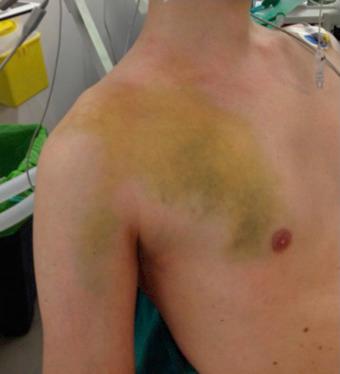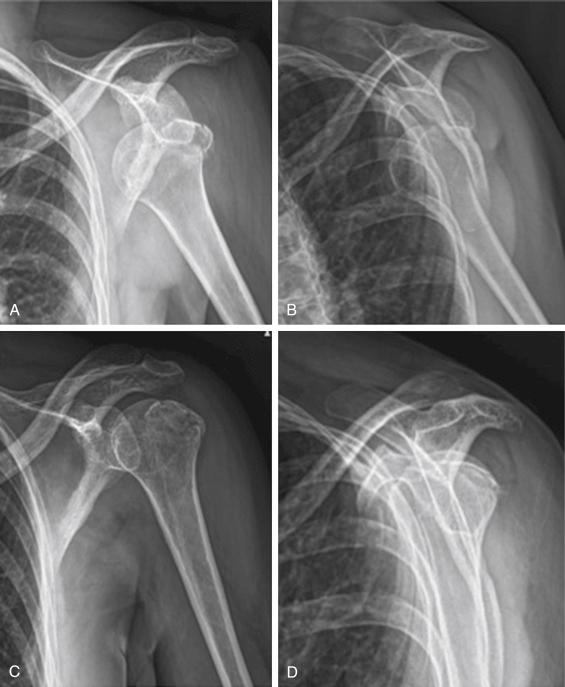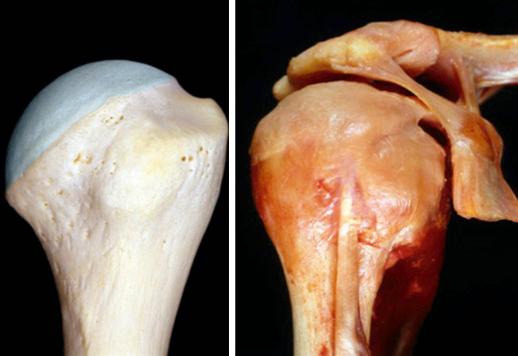Physical Address
304 North Cardinal St.
Dorchester Center, MA 02124
Although the incidence of greater tuberosity fractures of the proximal humerus has been estimated to be 20% of all proximal humerus fractures, lesser tuberosity fractures account for only 2%. Contrary to proximal humerus fractures, the typical patient who sustains this type of injury is a male, younger (between the second and fifth decades of life), and with good bone quality and fewer comorbidities. Greater and lesser tuberosity fractures can both be associated with glenohumeral (GH) dislocation, in an anterior and posterior direction, respectively.
Despite their benign appearance on radiological studies, the reported outcomes of greater and lesser tuberosity fractures are poor when treated inappropriately. The displacement of the fracture is conditioned by the integrity of the tendon insertions. It has been shown that small amounts of displacement of only 5 mm are responsible for a change in force vectors and a subsequent decrease in function. The degree of displacement that is an indication for surgery and how to measure it are still a matter of controversy. Obtaining appropriate x-ray projections or computed tomographic (CT) scans should be advocated in order to avoid misdiagnosis.
A conservative approach has been advocated for nondisplaced and minimally displaced fractures. When displacement is present, surgical treatment is recommended in order to improve functional outcome. A clear understanding of relevant anatomy, fracture patterns, patient characteristics, and associated injuries is mandatory to obtain satisfactory results.
Conservative management is indicated for minimally displaced fractures. It should include a period of immobilization followed by a specific rehabilitation program. Patients should be advised that the recovery period might be long and full range of motion might be difficult to achieve, owing to rotator cuff involvement.
Displaced fractures are treated surgically. Several techniques have been described, both open and arthroscopic. When the bony fragment is consistent enough and good bone quality is present, screw fixation might be the preferred option. Suture fixation with or without implants is also an excellent option when there is comminution or poor bone quality. Many different configurations are available. More recently, percutaneous or direct reduction performed in an arthroscopically assisted fashion has also been described.
Greater Tuberosity
More frequent in males
20–50 years old
Anterior GH dislocation (shearing/avulsion)
Direct fall onto the shoulder or with hyperabduction (impaction)
Males 20–50 years old
Avulsion or shearing mechanism (fall from motorcycle, bicycle, or horse, or down stairs)
Posterior GH dislocation (electrocution, epileptic seizure)
Adolescent with open physis (13–14 years old)
Sport-related injury
Dominant arm
Forced abduction and external rotation with eccentric subscapularis load
Pain and weakness
Shoulder swelling with point tenderness
Ecchymosis may extend into forearm and chest ( Fig. 29.1 ).

Neurological examination: axillary nerve
GH dislocation associated in 20%–30% (50% in patients over age 40 years)
Sensibility examination: lateral deltoid area
Motor examination: isometric contraction of deltoid muscle
Vascular injury: rare
Range of motion
Limited elevation and abduction (superior displacement)
Limited external rotation (posterior displacement)
Rotator cuff tear
Acute: uncommon
Weakness in older patients (differential diagnosis; axillary nerve palsy)
Failure to improve in nondisplaced fractures
Persistent displacement after reducing GH dislocation
Chronic: age and previous function
Posterior GH dislocation (subscapularis eccentric contraction, locked internal rotation)
Pain and weakness in internal rotation
Positive belly press test and lift-off (difficult in acute setting)
Adolescents
High index of suspicion needed: frequent delay in diagnosis
Pain in anterior part of the shoulder and internal rotation
Excessive passive external rotation
Positive belly press test and lift-off
Conventional x-ray ( Fig. 29.2A ,D)
True anteroposterior x-rays of the shoulder with the arm in neutral rotation to measure superior displacement (Grashey view).
Axillary view: helpful in determining angulation and displacement. In the case of GH dislocation, allows for detection of missed glenoid fractures.
True lateral view of the scapula to measure superior and posterior displacement and the degree of comminution.

CT scan
Glenohumeral dislocations
Identify if fracture affects articular surface or bicipital groove
Helpful in quantifying displacement
Magnetic resonance imaging (MRI)
Occasionally, one can identify a very small fragment that might correspond to one of the facets only and might indicate that a rotator cuff tear is present. In these cases, an MRI study could be more useful than a CT scan for detecting soft-tissue damage.
Conservative management: sling immobilization followed by a well-established rehabilitation protocol. It should be started within the first 2 weeks.
Surgical treatment:
Open or arthroscopic
Screw fixation
Suture fixation
Plate fixation
Apophyseal structure of the proximal humerus composed of three facets: superior, middle, and inferior ( Fig. 29.3 ).

The supraspinatus tendon was thought to insert on the superior facet and the superior half of the middle facet, whereas the infraspinatus tendon would insert on the entire middle facet, covering a portion of the supraspinatus tendon. However, a recent study described that the supraspinatus insertion was localized in the anteromedial and superior aspect of the tuberosity and that the infraspinatus insertion was located at the same height but in the anterolateral aspect of the superior facet and the entire middle facet.
Teres minor would occupy the inferior facet.
The highest point of the articular surface sits 8 ± 3.2 mm above the highest point of the greater tuberosity, preventing impingement against the acromion with arm motion.
When a fracture occurs as a result of the deforming forces, the tuberosity displaces in a superior direction owing to the supraspinatus and the superior part of the infraspinatus pull and in a posterior direction owing to the lower infraspinatus and teres minor pull.
Subscapularis tendon inserts in the lesser tuberosity.
The long head of the biceps tendon runs through the intertubercular groove and is restrained by both the transverse humeral ligament and fibers from the superior portion of subscapularis tendon and even some fibers from the supraspinatus tendon in the most lateral aspect.
The lesser tuberosity ossification center develops at 4 to 5 years of age, and the lesser and greater tuberosity fuse with each other between 5 and 7 years of age and with the humeral head between 7 and 13 years old. Some authors have pointed out that there might be a relative weakness of the lesser tuberosity during the period of skeletal growth and maturation, and these fractures might represent another “transitional” fracture of adolescence, similar to medial humeral epicondyle and others.
More than 5 mm of superior displacement
More than 3 mm of superior displacement in athletes, with overhead activity, in or heavy laborers
Shoulder instability after dislocation
Acute avulsion fracture in adolescents
Chronic impingement due to malposition of the fragment
Symptomatic nonunion in adolescents
Become a Clinical Tree membership for Full access and enjoy Unlimited articles
If you are a member. Log in here